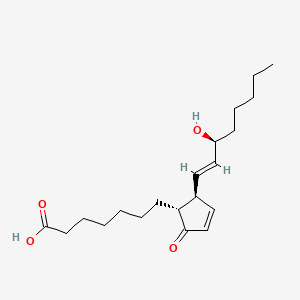| MeSH term | MeSH ID | Detail |
|---|---|---|
| Inflammation | D007249 | 119 associated lipids |
| Colonic Neoplasms | D003110 | 161 associated lipids |
| Body Weight | D001835 | 333 associated lipids |
| Leukemia, Erythroblastic, Acute | D004915 | 41 associated lipids |
| Glioma | D005910 | 112 associated lipids |
| Leukemia P388 | D007941 | 43 associated lipids |
| Brain Infarction | D020520 | 17 associated lipids |
| Infarction, Middle Cerebral Artery | D020244 | 35 associated lipids |
| Brain Ischemia | D002545 | 89 associated lipids |
| Nerve Degeneration | D009410 | 53 associated lipids |
PGA1
Pga1 is a lipid of Fatty Acyls (FA) class. Pga1 is associated with abnormalities such as Hyperostosis, Diffuse Idiopathic Skeletal, Polyglandular Type I Autoimmune Syndrome and Infection. The involved functions are known as Uptake, inhibitors, Binding (Molecular Function), Denaturation and Adjudication. Pga1 often locates in Extracellular, Plasma membrane, Cytoplasmic, Cytoplasm and Retrobulbar. The associated genes with PGA1 are AIRE gene, synthetic peptide and Recombinant Proteins.
Cross Reference
Introduction
To understand associated biological information of PGA1, we collected biological information of abnormalities, associated pathways, cellular/molecular locations, biological functions, related genes/proteins, lipids and common seen animal/experimental models with organized paragraphs from literatures.
What diseases are associated with PGA1?
PGA1 is suspected in Infection, Polyglandular Type I Autoimmune Syndrome and other diseases in descending order of the highest number of associated sentences.
Related references are mostly published in these journals:
| Disease | Cross reference | Weighted score | Related literature |
|---|
Possible diseases from mapped MeSH terms on references
We collected disease MeSH terms mapped to the references associated with PGA1
PubChem Associated disorders and diseases
What pathways are associated with PGA1
There are no associated biomedical information in the current reference collection.
PubChem Biomolecular Interactions and Pathways
Link to PubChem Biomolecular Interactions and PathwaysWhat cellular locations are associated with PGA1?
Visualization in cellular structure
Associated locations are in red color. Not associated locations are in black.
Related references are published most in these journals:
| Location | Cross reference | Weighted score | Related literatures |
|---|
What functions are associated with PGA1?
Related references are published most in these journals:
| Function | Cross reference | Weighted score | Related literatures |
|---|
What lipids are associated with PGA1?
There are no associated biomedical information in the current reference collection.
What genes are associated with PGA1?
Related references are published most in these journals:
| Gene | Cross reference | Weighted score | Related literatures |
|---|
What common seen animal models are associated with PGA1?
There are no associated biomedical information in the current reference collection.
NCBI Entrez Crosslinks
All references with PGA1
Download all related citations| Authors | Title | Published | Journal | PubMed Link |
|---|---|---|---|---|
| Anta B et al. | PGA1-induced apoptosis involves specific activation of H-Ras and N-Ras in cellular endomembranes. | 2016 | Cell Death Dis | pmid:27468687 |
| DÃez-Dacal B et al. | Molecular Interactions and Implications of Aldose Reductase Inhibition by PGA1 and Clinically Used Prostaglandins. | 2016 | Mol. Pharmacol. | pmid:26487510 |
| IsaÄ SV et al. | [An example of oscillatory (cyclic) reaction for prostaglandin chemistry]. | 2013 Jan-Feb | Biomed Khim | pmid:23650728 |
| Stotz HU et al. | TGA transcription factors and jasmonate-independent COI1 signalling regulate specific plant responses to reactive oxylipins. | 2013 | J. Exp. Bot. | pmid:23349138 |
| Hayashi Y and Umemiya S | Pot economy in the synthesis of prostaglandin A1 and E1 methyl esters. | 2013 | Angew. Chem. Int. Ed. Engl. | pmid:23404945 |
| Sugiyama R et al. | Induction of heat-shock protein 70 by prostaglandin Aâ‚ inhibits HIV-1 Vif-mediated degradation of APOBEC3G. | 2013 | Antiviral Res. | pmid:23831493 |
| DÃez-Dacal B and Pérez-Sala D | A-class prostaglandins: early findings and new perspectives for overcoming tumor chemoresistance. | 2012 | Cancer Lett. | pmid:22407242 |
| Brunhofer G et al. | Exploration of natural compounds as sources of new bifunctional scaffolds targeting cholinesterases and beta amyloid aggregation: the case of chelerythrine. | 2012 | Bioorg. Med. Chem. | pmid:23062825 |
| DÃez-Dacal B et al. | Identification of aldo-keto reductase AKR1B10 as a selective target for modification and inhibition by prostaglandin A(1): implications for antitumoral activity. | 2011 | Cancer Res. | pmid:21507934 |
| Garzón B et al. | A biotinylated analog of the anti-proliferative prostaglandin A1 allows assessment of PPAR-independent effects and identification of novel cellular targets for covalent modification. | 2010 | Chem. Biol. Interact. | pmid:19800325 |
